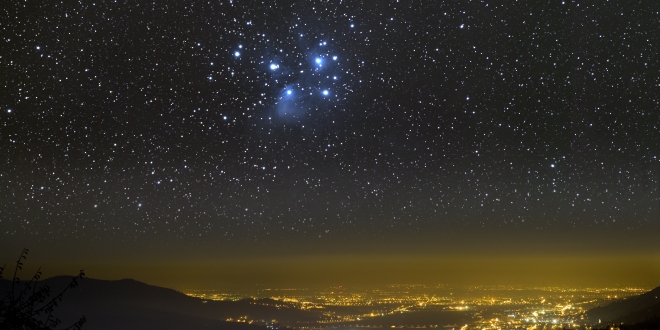Many of us relish over the idea of driving out in the country at night to lie in the middle of a field and gaze up into a dark sky filled with stars. Unfortunately, this is now considered a rare experience. Gazing at the stars is not just always outside the door, stargazing now requires planning and often at least an hour of driving from major metropolitan areas due to one major problem – light pollution.
Excessive light pollution is even becoming a problem in larger rural areas. If steps aren’t taken to reduce pollution, gazing up at the stars may quickly become a pastime for many.
Below, we’ll highlight important measures you can take to manage outdoor lighting. Measures that make a a world of difference. Every little bit counts and now is the time to promote dark skies.
There are many reasons people choose to implement outdoor lights – illuminating for safety, security, architecture, or just because. While there’s no way to fully eliminate outdoor lighting, there are a number of ways to cut down on the light pollution levels in your area and it can start with the just one light bulb.
The Proper Light Bulb
The International Dark Sky Association has developed an extensive list of standards to reduce light pollution, and certifies good dark sky lighting practices with an IDA seal of approval. Warmer colored lamps are often a better solution as opposed to cool colored LED’s as they are a softer light and often offer less spill and bounce than brighter, whiter fixtures. Choosing lower wattage fixtures is also a great step to take – in general for outdoor, 80 watts is usually more than sufficient.
Shielded Fixtures
Shielded fixtures ensure that the artificial light from that particular source is shining directly down. For a certain larger lamp, having the light shine directly down optimizes the purpose of the light and also reduces light trespass. This concept, formally referred to as ‘shielding’, directs all light towards the ground to revert any spill into the sky. Many floodlights, PAR lights, and decorative light fixtures are sadly unshielded. In order to qualify as a shielded fixture, the fixture itself must redirect light so that no light is emitted above the lamp, only below. In high traffic areas, proper shielding also reduces glare to drivers and increases pedestrian safety.
Landscape Lighting
Another big dark sky offender is up-lighting, such as landscape lighting. By nature of the design, these types of lighting fortunately cannot be shielded, and are a large contributor to light pollution. Depending on focus and the intensity of the lights, many forms of landscape lighting can actually dry out trees and plants by the heat they emit, especially on leaves. Even more importantly, plants have internal growth patterns that function based off of light levels. Similar to if humans were in a light filled room 24/7, if trees and plants are constantly in the light, they never know when to sleep. This prevents plants from developing naturally.
Street Lights
A good place to begin change is right at home. After you got a good grip on good outdoor lighting techniques, you can take it up to another notch and help decrease light pollution in your community. Contact your power or utility company and make sure they are using shielded street lights, as well as making sure the street lights have sensors. There’s no reason for street lights to be on at full all night, when they could have a native state of 50% intensity, and bump to full when they sense motion around them.
Ecosystem & Human Health
Excessive artificial lights are bad for the environment and bad for human health. According to Environment Health News, artificial light brings disease and unrest to the bug kingdom. Could you imagine being a magnet and flying into an overly lit light all night long? On top of this, the amazing and magical firefly species is dropping in population rapidly due to human development and artificial over-illumination. Studies also show that over-illumination can affect human health, such as sleeplessness.
Final Thought
Being able to see the stars at night is a right we should all be able to embrace. Creating a safe and healthy home for our ecosystem, including bioluminescent creatures, is just the right thing to do. While lights are vital for safety, using optimum and intelligent lighting techniques can actually benefit beyond just safety but create that window to the universe.

Lights are vital to the illusion of safety but not safety itself. For physical access there is no reason why fully-shielded, low-intensity lights cannot work at night. And as far as threat to property, thieves operate both day and night. Bright glaring floodlights only create more shadows to hide in. Motion sensing lights, again fully-shielded as you mention, are the best option if theft is really a concern.
LikeLiked by 1 person
Indeed, indeed 🙂 Thank you for your comment.
LikeLiked by 1 person
Thank you for this thoughtful and very necessary post. I’m one of the fortunate ones who can step outside to stargaze without hindrance of too much human-produced light. As a society we’ve focussed on reducing our footprints in wild areas — we need to pay the same attention to light pollution.
LikeLiked by 1 person
Hi Sally, thank you for your comment. You are indeed very fortunate to see an array of stars at night. “The Milky Way is the path of the Gods” .. 🙂
LikeLiked by 1 person
Ah … 🙂
LikeLiked by 1 person
Great Article, I never thought of the impact landscape lighting had on light pollution.
LikeLiked by 1 person